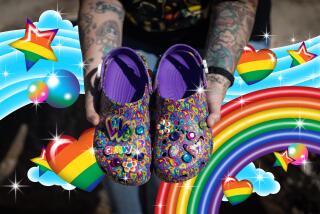Footwear Industry Steps Up to Meet Needs of Baby Boomers
- Share via
NEW YORK — Until last spring, Linda Mann was willing to squeeze her size 9 foot -- bunions and all -- into the latest trendy footwear just to impress her clients or dates.
But the 54-year-old public relations executive vows never again, after she fell flat on her face and broke bones in her left foot while making a getaway on wobbly heels from a bad blind date.
“I was on my cell phone to my daughter complaining about my date, and I fell on a crack,” said Mann, of Manhattan. “I was in such pain, and couldn’t walk. I can’t live with the stress of knowing I can fall. At the same time, I don’t want to wear shoes that make me look like a dork.”
The footwear industry is waking up to the growing demands of Mann and other baby boomers who have been slaves to the styles of the decades -- from platform shoes to stiletto heels -- but who no longer are willing to suffer in the name of fashion.
Boomers still want stylish footwear, but now, with aging feet, they’re looking for more comfortable shoes without having them look orthopedic.
Major retailers such as Proffitt’s, Nordstrom, Macy’s and J.C. Penney are all responding by stocking up on wider widths and bigger sizes or working with suppliers to add more cushioning for the 38 to 56 age group.
A year ago, Penney created a “comfort zone” in its women’s shoe departments, featuring brands such as Clarks and Rockport. It will be launching similar departments for men later this year.
Meanwhile, brands such as Naturalizer and Easy Spirit -- known for their extra cushioning and flexible soles -- are overhauling their dowdy images by offering such youthful styles as mules and platforms.
Shoe designer Stuart Weitzman has added wider sizes and used foam in all of his shoes, including strappy sandals. And two years ago, upscale footwear brand Cole Haan began incorporating tiny air bags into some of its shoes, using its parent Nike Inc.’s technology.
New shoe companies catering to boomers have formed as well, including Taryn Rose International LLC, started by an orthopedic surgeon. The women’s and men’s shoe line, sold at high-end stores and featuring lambskin and stretch materials, is priced at $325 and up.
Still, while there’s an effort to offer more comfort, the latest shoe trends -- long, skinny, pointed shoes, ankle straps, and curved-in heels from the likes of such trendsetters as Jimmy Choo -- signal that enduring pain is still a must for being a fashionista.
“At the same time the industry is offering healthy shoes, it’s also offering higher heels and more unhealthy styles,” said Dr. Glenn Pfeffer, a San Francisco-based orthopedic surgeon who is on the board of the American Academy of the Orthopedic Surgeons. “I am anticipating a boom in business in [foot] surgery.”
After age 40, stiffness in the Achilles tendon, which connects the calf muscles to the heel bone, sets in. Soles of the feet lose fat cells, giving boomers less cushion for walking. Aging adults also will find their feet getting larger as ligaments stretch out, Pfeffer said.
Pfeffer believes boomers have more difficult foot problems than senior citizens because they are the ones leading more active lives, commuting to work and busy running around with children.
Still, marketing to this generation is tricky because boomers don’t want to feel old.
Candace Corlett, a marketing consultant, said brands such as Easy Spirit and Naturalizer still have an uphill battle to appeal to this audience. “They’re still identified with old feet,” she said.
But Naturalizer has seen the average age of its customer drop 24 years, to age 40, since 1998, said Brad Adams, senior vice president of Naturalizer’s retail division, a division of Brown Shoe Co.






